Assignment report: A Super Mario VR Museum with movable models and interactive features
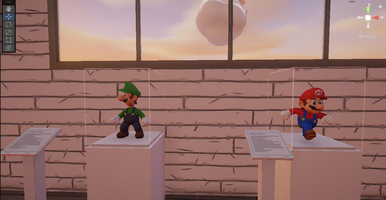
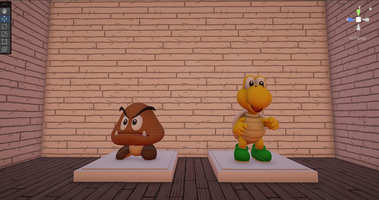
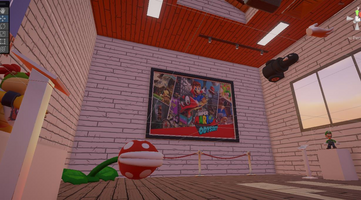

Nobody can say no to Super Mario. By using my Super Mario VR Museum, take a closer look at the popular characters from Super Mario Bros, Even the Nintendo Switch can't offer you the intimate experience of standing face-to-face with Mario, Luigi, Peach, and the rest of the iconic cast.
Description of the application
As Furness III said, Humans work best with 3D motor control. When you want to create a Virtual Museum, compared to viewing exhibits on a monitor, using your mouse to roll up and down to view the picture or 3D model of the exhibits, VR technology can provide a much better experience. With VR technology, you can get close to the exhibits, and feel the true texture and size of the exhibits.

What I created is a VR Super Mario Museum. By using High-precision game models and VR interaction system, you can move freely in the 3D museum, and enjoy the funny and moveable models of Mario, Luigi, Peach, and other famous characters. Unlike playing Mario games on consoles, you can gain a special experience like the Mario Bro standing right in front of you and the big cannibal wanting to eat you! Not only for Mario’s fans, but also for people who don’t know much about Mario, they can learn about these world’s most famous game characters through real feeling.
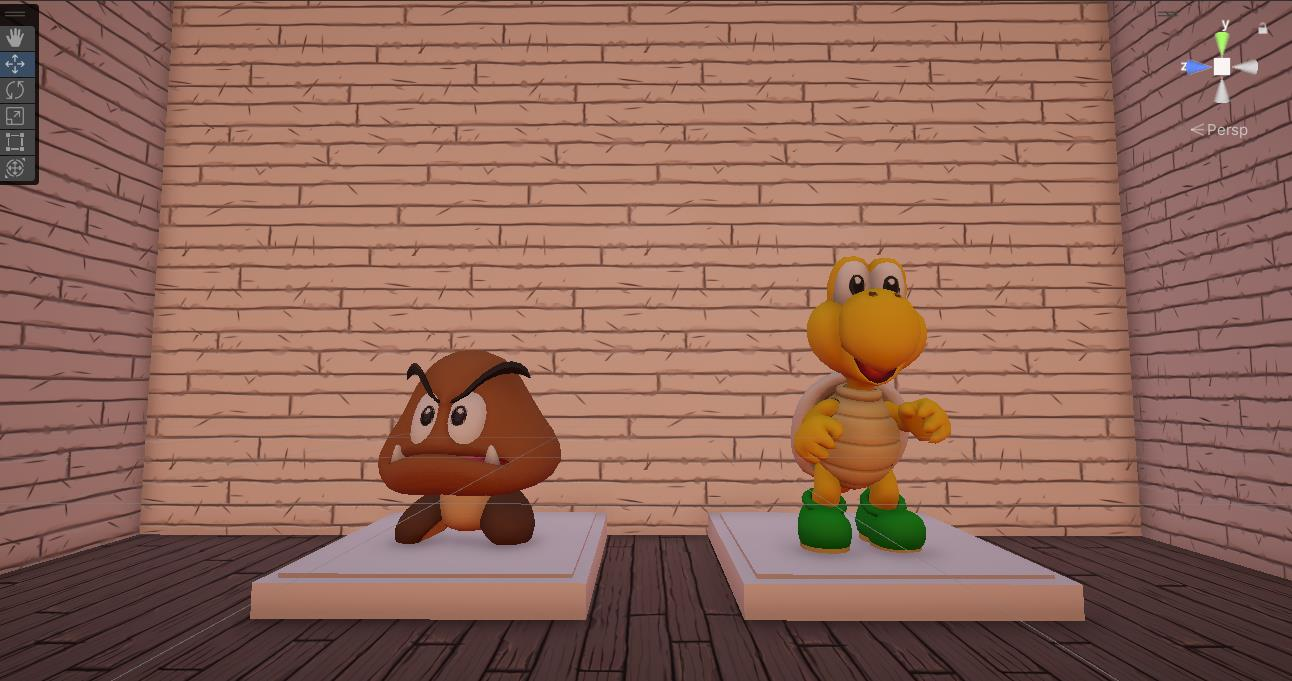
What I created is a VR Super Mario Museum. By using High-precision game models and VR interaction system, you can move freely in the 3D museum, and enjoy the funny and moveable models of Mario, Luigi, Peach, and other famous characters. Unlike playing Mario games on consoles, you can gain a special experience like the Mario Bro standing right in front of you and the big cannibal wanting to eat you! Not only for Mario’s fans, but also for people who don’t know much about Mario, they can learn about these world’s most famous game characters through real feeling.
Interaction Design in VR Museums
Incorporating real-time user feedback in VR design, as demonstrated by Krietemeyer et al., can provide valuable insights into how interactive systems are received and performed [1]. The core advantage of VR museums over traditional online museums is the realism and interactivity of the exhibits. This kind of feedback brought by VR is not only visually appealing but also enhances the user experience and user engagement, making the museum more attractive.
Compared to real-world museums, the advantage of VR museums lies in the number of exhibits as well as the scalability of the pavilion area, it is bound only by imagination. When given enough time and developers, VR museums can be scaled up to very sizable proportions, offering a wealth of exhibits and experiences that real museums cannot provide.
Building on these strengths, the prototype of the Super Mario VR Museum introduces two interactive features:
The first one is the Interactable Information board.
In real-world museums, if you want to get an in-depth look at the exhibits, you must borrow a museum docent or follow a guide. But in this VR application, users can interact with the information board and direct access to a clear introduction to the exhibits. This concept aligns with the "Invisible Museum" which was introduced by Zidianakis et al., where a user-centric platform allows for the creation of interactive and immersive virtual 3D/VR exhibitions [2]. Furthermore, by using XR components, the digital information board can be used to control the direction and attitude of exhibits, even controlling the environment or BGM.
The second function is visualization teleportation.
The key advantage of the VR museum is the possibility scale. If you want to make a Large-scale Museum, using the joystick to move around can be slow and reduce the user's experience. My prototype Museum’s scale is not very big, but the visualization teleportation still can improve the moving experience, letting you teleport right to the exhibit you want to see. This concept is reminiscent of the virtual arboretum described by Harrington et al., which emphasized the importance of free choice in navigation and high fidelity in VR applications [3]. In later versions, as the museum expands, visualization teleportation will show even more benefits.
In conclusion, the Super Mario VR Museum is not only a tribute to a legendary game series but also a prototype that expresses the potential of VR in perceiving and interacting with digital content. With the improvement of my development skills and technological advances, the user experience will be much better, and it will offer experiences that are not just immersive but also enter deeply into the hearts of people.
Technical Development
Information board:
By using the XR Simple Interactable component/interactable event, when you use hands to grab the information board, an introduction UI (User Interface) will automatically jump out. Users can read all the characters’ information through it. When you don’t need the introduction UI, you can hover the information board again and it will disappear.

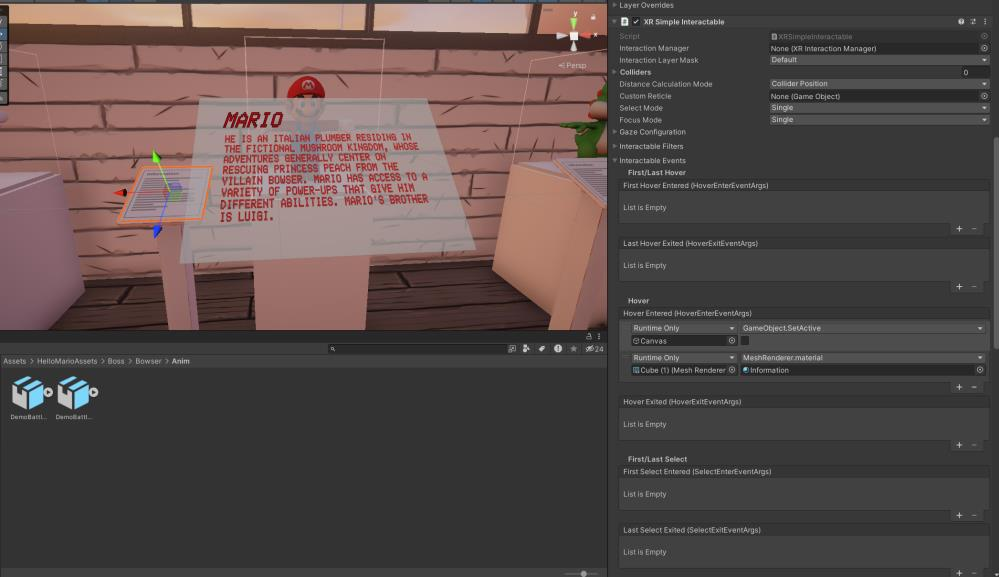
In this prototype application, I used this component to implement this simple but critical feature, but it still has many hidden capabilities. In the next vision, I can add more functions to the UI. For example, tap to interact with the model to make it move or make different in-game sound effects.
Visualization teleportation:
In order to enhance visual effects, I used the XR Ray Interactor component to let the indicator ray dropping to the ground in a natural parabola. A disk for indication has been added where the ray meets the ground to mark the position of the transmission.
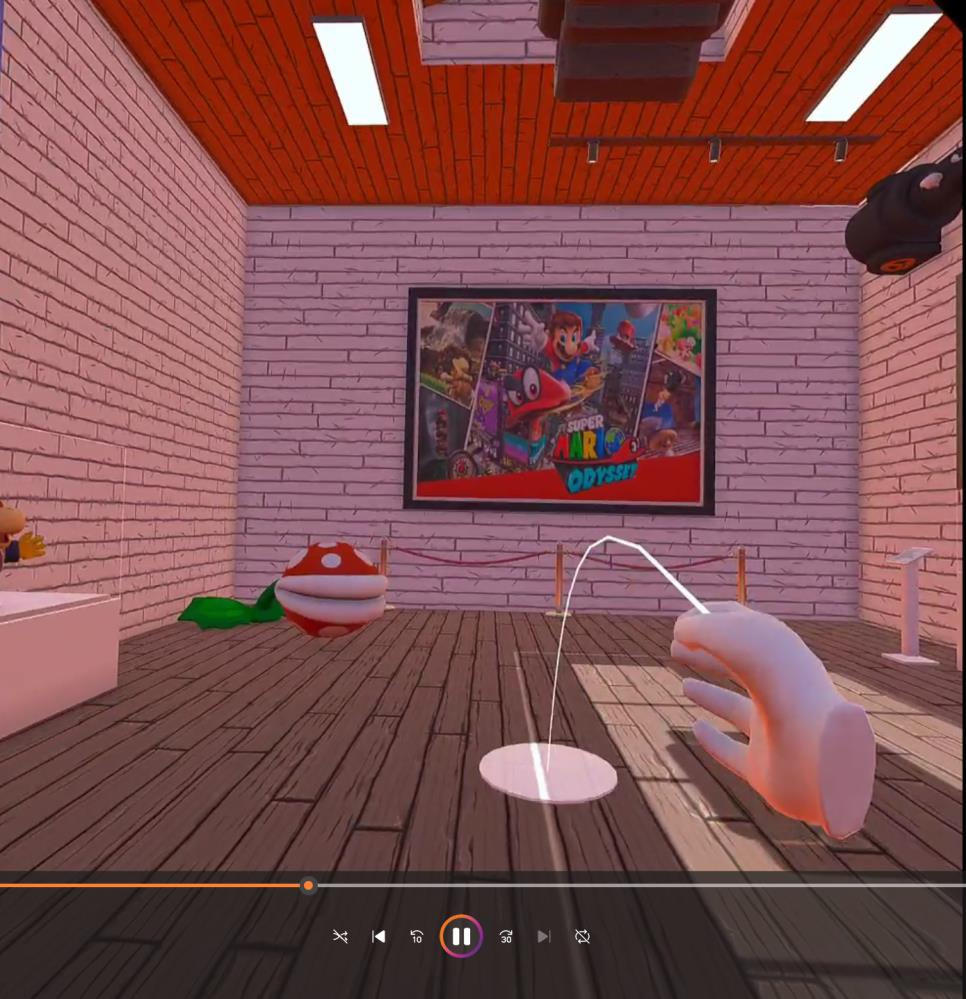
The teleportation functions also have father capabilities. For example, if the Museum has different theme area, I can introduce a coordinate teleportation feature to improve the user's movement efficiency and experience.
Descriptions of 3D Models
In this application, I used 2 model sets. The first one is AK Studio Art. It provides an expendable museum model; I can also DIY the material and the composition of the model to meet the theme of the exhibition.
The second one is HelloMarioAssets. It is an open-source game model set, which can be freely used for learning purposes. It provides characters and items model from various generations of Super Mario games with animation set. This model set is the core of this application, providing all the exhibits.
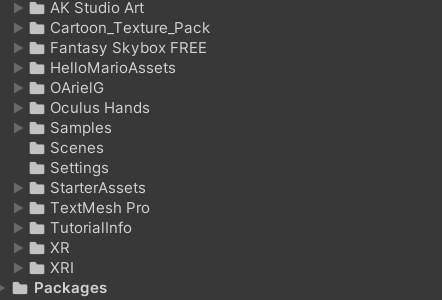
The other resources include FREE Stylized PBR Textures Pack and Fantasy Skybox FREE, provide floor/wall materials and the sky box of my application.
References
[1] Art Gallery Vol.1 (https://assetstore.unity.com/packages/3d/environments/art-gallery-vol-1-121479)
[2] HelloMarioAssets( https://hellofangaming.github.io/HelloMarioAssets/)
[3] FREE Stylized PBR Textures Pack (https://assetstore.unity.com/packages/2d/textures-materials/free-stylized-pbr-textures-pack-111778)
[4] Fantasy Skybox FREE (https://assetstore.unity.com/packages/2d/textures-materials/sky/fantasy-skybox-free-18353)
[5] Valem Tutorials. How to Make a VR Game in Unity (
)
Academic Reference
[1] Krietemeyer, B, Bartosh, A, & Covington, L 2017,“Shared Realities: A Method for Adaptive Design Incorporating Real-Time User Feedback using Virtual Reality and 3D Depth-Sensing Systems,” in, ACADIA 2017: Disciplines and Disruption, Cambridge (Massachusetts), USA, pp.330–339, viewed 20 August 2023, <http: papers.cumincad.org="" cgi-bin="" works="" paper="" acadia17_330="">. </http:>
[2] Zidianakis, E et al. 2021, “The Invisible Museum: A User-Centric Platform for Creating Virtual 3D Exhibitions with VR Support,” Electronics, vol. 10, no. 3, p. 363.
[3] Harrington, MCR et al. 2021, “Designing a Virtual Arboretum as an Immersive, Multimodal, Interactive, Data Visualization Virtual Field Trip,” Multimodal Technologies and Interaction, vol. 5, no. 4,